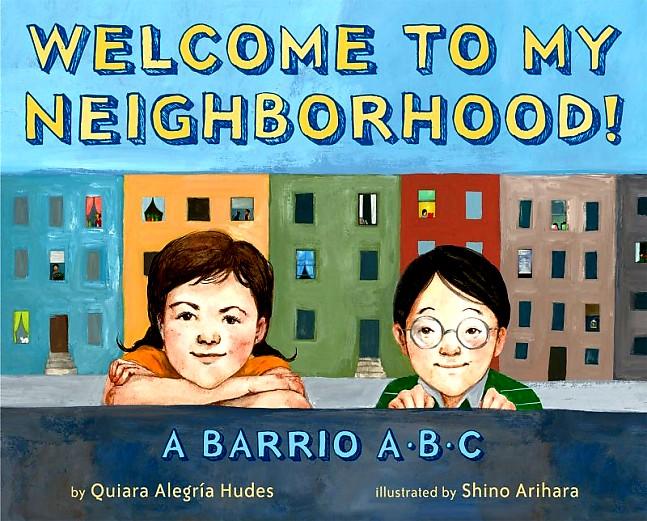
Title: Welcome to my Neighborhood! A Barrio A B C | Author: Quiara Alegría Hudes | Illustrator: Shino Arihara | Publisher: Arthur A. Levine Books, Scholastic INC.
| Date of Publication: 2010 | ISBN: 978-0545094245 | Number of pages: 32 | Grade Level: Pre-School-3 | Literary Trend: Spotlight on Diversity
Hudes, Q.A. (2010). Welcome to my Neighborhood! A Barrio A B C. New York, NY: Arthur A. Levine Books.
This thoughtful alphabet picture book offers readers a peek into the urban neighborhood of a young girl as she gives a tour to her new friend. From one page to the next, culture and regionally specific landmarks are showcased as vital parts of the community. Humor and joy are dominant themes and children will be entertained by viewing the worldview of the young narrator. Open fire hydrants on a summer day, walking past grandmothers sitting at their open windows, a young muralist painting a wall, and swinging at the playground are all a part of the daily routine. The book however, does not omit some of the other elements of urban life, abandon automobiles and burned down buildings are intersected with minimal fanfare.
Although the picture book is not offered as a bilingual edition, the Spanish language version ¡Bienvenidos a Mi Barrio! Mi Mundo de la A a la Z, offers a near identical translation, with some crucial variations that are allowed to rely heavier on the Spanglish speaking community nomenclature and offer a less dismal view of the neighborhood at times, Nosy Neighbors, for instance, become laid back social interactions, and dangerous Z street becomes Zona escolar (school zone) where young pedestrians always have the right of way. These slight variations appear to be second thoughts as some illustrations seem to work better than others depending on the language, but young readers will likely not take this into account.
Booklist offers an interesting perspective on the format of the book when it points out the advanced level text and “sophisticated concepts” for an alphabet book might confuse new and advanced readers alike. School Library Journal observes the muted tone of the illustrations as an accurate rendition of the urban landscape and but that occasionally “profiled or turned faces restrict readers from viewing the emotion to match the strength of the author’s words.” Similarly, I found that the book would be more powerful and useful as a bilingual text, as the cultural and literacy didacticism that is exhibited in this book is ideal for second language learners, both from Spanish to English and vice versa.
Welcome to My Neighborhood! offers early cultural literacy and is aimed perhaps more towards a family read along rather than an individual reading. Other titles however, offer similarly complex cultural glossary in alphabet book form that might have a stronger effect on young and advanced readers, such as the book A is for Activist, printed in board book format and written in sing-song verse, allowing for a diverse range of reading styles, but definitely geared towards co-reading by parent and child. Welcome to My Neighborhood! is more straightforward in its pacing and depending on the reader, an introduction may be necessary for a true understanding of the sometimes sophisticated poetic text and cultural references.